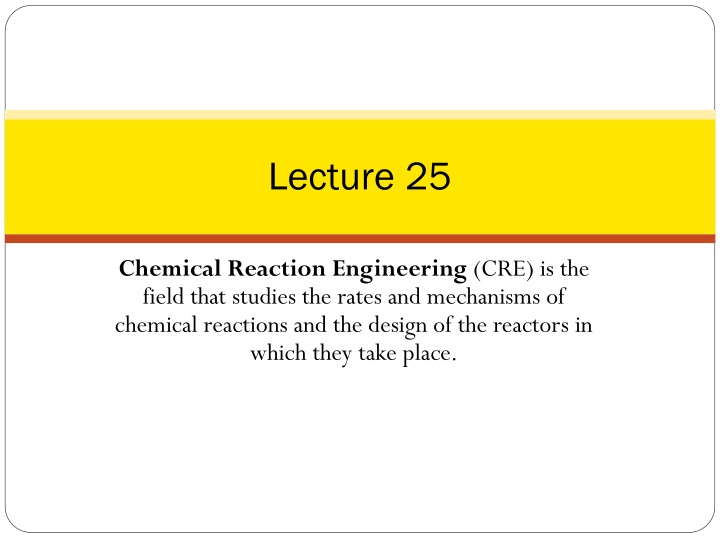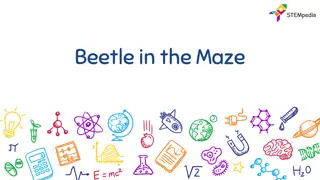
Chemical Reaction Engineering: Rates, Mechanisms, and Reactor Design
"Chemical Reaction Engineering (CRE) delves into the rates, mechanisms, and design of reactors for chemical reactions. Explore examples, cases, and safety considerations in this field."
Download Presentation

Please find below an Image/Link to download the presentation.
The content on the website is provided AS IS for your information and personal use only. It may not be sold, licensed, or shared on other websites without obtaining consent from the author. If you encounter any issues during the download, it is possible that the publisher has removed the file from their server.
You are allowed to download the files provided on this website for personal or commercial use, subject to the condition that they are used lawfully. All files are the property of their respective owners.
The content on the website is provided AS IS for your information and personal use only. It may not be sold, licensed, or shared on other websites without obtaining consent from the author.
E N D
Presentation Transcript
Lecture 25 Chemical Reaction Engineering (CRE) is the field that studies the rates and mechanisms of chemical reactions and the design of the reactors in which they take place.
Web Lecture 25 Class Lecture 21 CSI Ammonium Nitrate Explosion Monsanto Explosion T2 Laboratories Explosion 2 2
Case 1 Ammonium Nitrate Explosion Massive blast at Terra plant kills four. 3 3
Example 1: Safety in Chemical Reactors H2O N2O Gas 17%H2O T0=200 F mA0= 310lb h P 200 F Liquid 83%NH4NO3 510 F NH4NO3 M 500 lb X Ta0 Ta NH4NO3 N2O+2H2O 4 4
Example 1: Safety in Chemical Reactors Only liquid A in the vat as the product gases N2O and H2O escape immediately after being formed. Q Q dT g r = dt N C A PA = ( )( ) Q r V H g A Rx = + + ( ) ( ) ( ) Q F C T T H H UA T T 0 0 0 r A PA B B B a 5 5
Unsteady State Energy Balance Q Q T g r ( )( ) ( ) ( ( ) ) + H r V F C T UA T T dT Rx A A 0 i P 0 a = i dt N C i P i Adiabatic Qr= FA0CPAT 660 )+ W1134 + CPWT 960 ( ) ( ( ) FA0= 0 HRx ( NiCPi ) rAV ( ) T dT dt = If the flow rate is shut off, the temperature will rise (possibly to point of explosion!) t (min) 6 6
Case 2 Monsanto Chemical Company Keeping MBAs away from Chemical Reactors The process worked for 19 years before they showed up! Why did they come? What did they want? 7 7
Nitroanline Synthesis Reaction NO2 NO2 Cl NH2 + 2NH3 + NH4Cl ONCB + Ammonia Nitroanaline Chloride + Ammonium 8 8
Nitroanline Synthesis Reaction NH3in H2O ONCB Autoclave 175 oC ~550 psi NH3 Filter Press O-Nitroaniline Product Stream Separation To Crystallizing Tanks fast Orange 9 9
Nitroanline Synthesis Reactor Old 3 kmol ONCB 43 kmol Ammonia 100 kmol Water V = 3.25 m3 10 10
Same Nitroanline Synthesis Reaction NO2 NO2 Cl NH2 + 2NH3 + NH4Cl ONCB + Ammonia Nitroanaline + Ammonium Chloride Batch Reactor, 24 hour reaction time Management said: TRIPLE PRODUCTION 11 11
MBA-Style: Nitroanline Synthesis Reactor New 9 kmol ONCB 33 kmol Ammonia 100 kmol Water V = 5 m3 12 12
Batch Reactor Energy Balance Q Q g r r ( = V )( H + ) UA + ( T T ) dT A rx 0 dt N C N C N C A 0 pA B 0 pB W pW = + + NC N C N C N C P A 0 pA B 0 pB W pW Q Q dT g NC r = dt p 13 13
Batch Reactor Energy Balance Q Q dT g NC r = dt p The rate of heat removed is = UA ( ) Q m C T T 1 exp Equation (12 - 13) p547 r c P a 1 m C c c P c For high coolant flow rates, , the maximum rate of heat removal is c m ( ) Qr=UA T Ta ( C )( ) = = Q r ( V ) H r V H The rate of heat generated is g A Rx = A C Rx r k A 1 A B H ( ) = Q k C C g 1 A B Rx 14
Batch Reactor Energy Balance dT dT=Qr Qg Recall NCPS For isothermal operation at Qr = Qg, T = 448 K ( ) Q ( )( )( ) = 2 A Q k 448 K C 1 X X H g 0 B Rx = Q r g UA ( ) ( . 0 ) ( ) = 2 A m C T T 1 exp 0001167 C 1 X c P a 1 0 m C c c P c Vary to keep heat removed equal to heat generation c m 15 15
Isothermal Operation for 45 minutes At the time the heat exchanger fails = = X 0.033, T 448 K = = 3850 / min Q r V H kcal g A Rx = 5378 The maximum rate of removal at T 448 K is ( ) = = = 35 85 . ( 448 298 ) / min Q UA T T kcal r a Q Q Everything is OK r g
Adiabatic Operation for 10 minutes = = = 45 min . 0 033 448 = t X T K = = 55 = min . 0 0424 468 t X T K 6591 / min Q kcal g = 6093 Q r / min Q kcal r Q g Q Q dT = = 2 . 0 / min C g r dt NC p
Temperature-Time trajectory Q Q dT = 2 . 0 = / min C q r dt N C p Temperature oC 400 Cooling Restored Qr= 0 Isothermal Operation 200 175 fuse 9:55 t = 0 10:40 10:50 midnight 12:18 18
Disk Rupture The pressure relief disk should have ruptured when the temperature reached 265 C (ca. 700 psi) but it did not. If the disk had ruptured, the maximum mass flow rate out of the reactor would have been 830 kg/min (2-in orifice to 1 atm). ( ) = + Q m H UA T T r vap vap kcal a = Q 449 000 , r min kcal = Q 27 , 460 g min Q Q r g No explosion
All the following three things must have occurred for the explosion to happen x3!!! 1. Tripled Production 2. Heat Exchange Failure 3.Relief Valve Failure 20 20
Case 3 Manufacture of Fuel Additive methylcyclopentadiene manganese tricarbonyl (MCMT) 21 21
Production of methylcyclopentadienyl manganese tricarbonyl (MCMT). Step 1a. Reaction between methylcyclopentadiene (MCP) and sodium in a solvent of diethylene glycol dimethyl ether (diglyme, C6H14O3) to produce sodium methylcyclopentadiene and hydrogen gas: Step 1b. At the end of Step 1a, MnCl2is added to the reactor. It reacts with sodium methylcyclopentadiene to produce manganese dimethylcyclopentadiene and sodium chloride: Step 1c. At the end of Step 1b, CO is added. The reaction between manganese dimethylcyclopentadiene and carbon monoxide produces the final product, methylcyclopentadienyl manganese tricarbonyl (MCMT), a fuel additive. 22
Only consider Step 1 Desired Reaction Undesired Reaction of Dygline Simplified Model Let A = methycylcopentadiene, B = sodium, S = Solvent (diglyme), and D = H2. These reactions are: r1A= r1B=k1ACACB (1) A + B C + 1/2 D (gas) (2) S 3 D (gas) + miscellaneous liquid and solid products r2S=k2sCS HRx1A= 45,400J mol HRx2S= 3.2 105J mol 23
Case 3 Manufacture of Fuel Additive (2) Rates Laws: Net Rates: (3) Stoichiometry Liquid Phase 26 26
Case 3 Manufacture of Fuel Additive (4) Energy Balance: =1.26 107J K HRx1A= 45,400J mol HRx2S= 3.2 105J mol 27 27
28 28
End of Web Lecture 25 Class Lecture 2 29 29






















